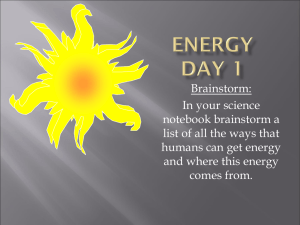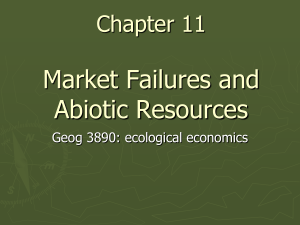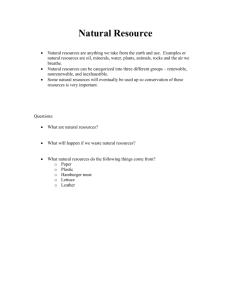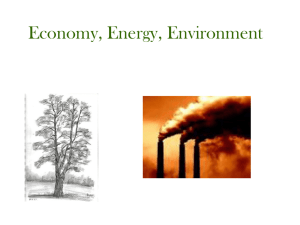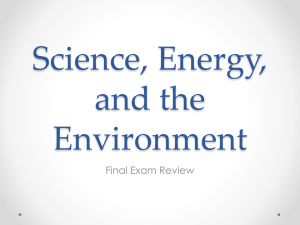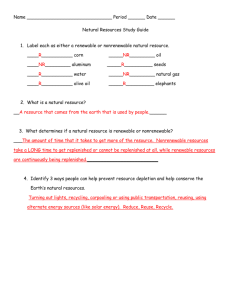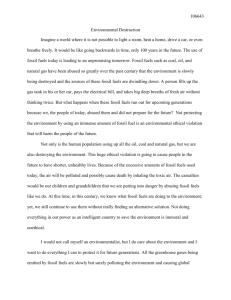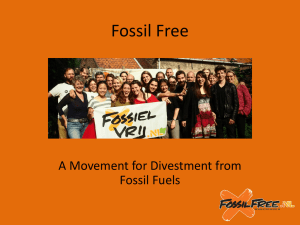Ecology Study Guide Answers
advertisement
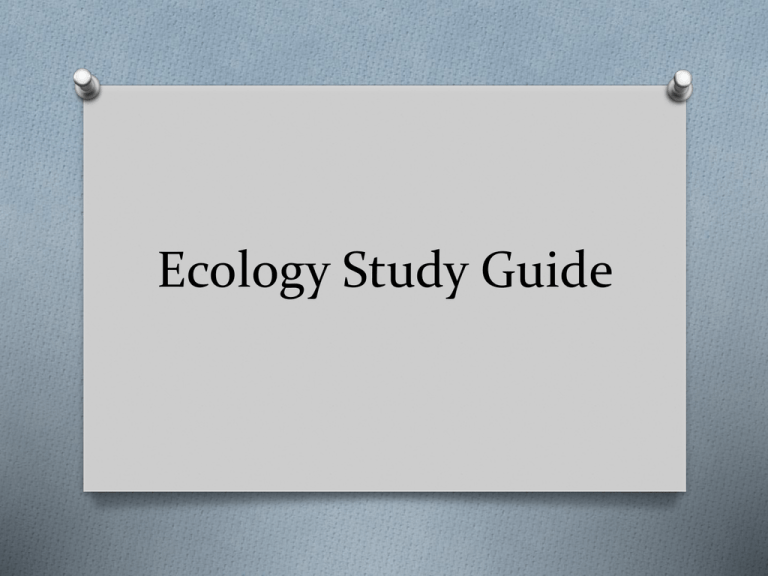
Ecology Study Guide What is a renewable resource and give 3 examples? A renewable resource is a natural resource that can be replaced at the same rate at which the resource is consumed. Examples include: wind, water, trees, solar What is a nonrenewable resource and give 3 examples? A nonrenewable resource is a resource that forms at a rate that is much slower than the rate at which it is consumed. Examples: coal, oil, natural gas, minerals What are fossil fuels and what are they used for? Fossil fuels are nonrenewable energy resources that are formed from the remains of organisms that lived long ago. Fossil fuels are used to make energy. What ways do we obtain fossil fuels? To obtain fossil fuels we must either use: Surface mining Subsurface mining Drilling wells What problems occur from using fossil fuels? Problems that occur when using fossil fuels include: POLLUTION – including smog and acid rain Fossil fuels will become hard to find Describe three ways that humans can conserve natural resources. Three ways humans can conserve natural resources: Use less fossil fuels Recycle when possible Keep water and soil clean Briefly explain how coal, petroleum, and natural gas are formed. Coal forms when plants die (usually in swampy areas) and over millions of years are buried by dirt and water. Then heat and pressure turn the plants into coal. Petroleum and natural gas form when sea plants and animals die and are buried on the ocean floor. Over time the remains are buried by sand and silt and are pushed deeper into the Earth’s crust. Heat and pressure are applied and oil and gas are made. Describe the following alternative energy forms. Give one advantage and one disadvantage for each. Biomass Biomass is when organic matter is used as a source of energy. Biomass gets its energy from the sun and stores it for later use. The most common way biomass is used is to be burned. One advantages could be biomass is renewable and can be inexpensive. Disadvantages include the fact that it requires land to grow, and it does not produce enough energy to keep up with our needs. Hydroelectric Hydroelectric energy is electrical energy produced from falling water. Advantages of hydroelectric power include: Causes little pollution Gives off significant amounts of energy Could reduce the amount of fossil fuels used Disadvantages of hydroelectric power include: You must be near a water source You must build dams and they create erosion problems and decrease water quality Large numbers of fish die due to dams as well as destroys forests and wildlife habitats Geothermal Geothermal energy is energy produced by the heat within the earth. Advantages of geothermal energy include: Can be used to heat buildings Produces a great deal of energy Disadvantages include: Expensive to set up Available only in certain areas Wind Wind energy is an indirect form of solar energy through unequal heating of air. To harness wind energy you need windmills. Advantages: can generate significant amounts of energy Doesn’t cause pollution Disadvantages: Unreliable due to wind that isn’t strong enough or frequent enough to depend on Solar Solar energy is energy from the sun in the form of radiation. Advantages: Can be used directly for heat Doesn’t produce pollution Disadvantages: Expensive to set up We do not have the correct technology to produce enough electrical energy that we need Nuclear Nuclear energy is the energy released by a fission or fusion reaction between atoms. Advantages: Very powerful Disadvantages: Produce dangerous radioactive wastes Needs special environments to be safe The energy contained in fossil fuels comes from where? The energy contained in fossil fuels comes from energy absorbed by the original organisms from the sun. What is uniformitarianism? Principle that states geologic processes that occurred in the past occur today and happen gradually What is recycling? Reusing? And Reducing? Recycling is the process of recovering valuable or useful materials from waste or scrap. Reusing is using a material more than once to save the amount of materials you have available. Reducing is cutting down on the amount of materials used for certain things. Where is geothermal energy found? Geothermal energy is found deep within the earth. Geothermal energy usually comes to the surface of the earth as geysers, natural vents, or wells drilled in rocks. What environmental problems are caused by burning petroleum? Smog is a photochemical haze that forms when sunlight acts on industrial pollutants and burning fossil fuels. What is the difference between renewable and nonrenewable resources? Renewable – resource that can replenish itself at a rate equal to or fast than it is used. Nonrenewable – resources that humans use fast than they can be replenished. Explain the role of the sun as a major source of energy. List all energy sources that originate from the sun. The sun is the major source of energy for almost all types of energy we use. For example, the energy we get from water, wind, fossil fuels, and biomass.

